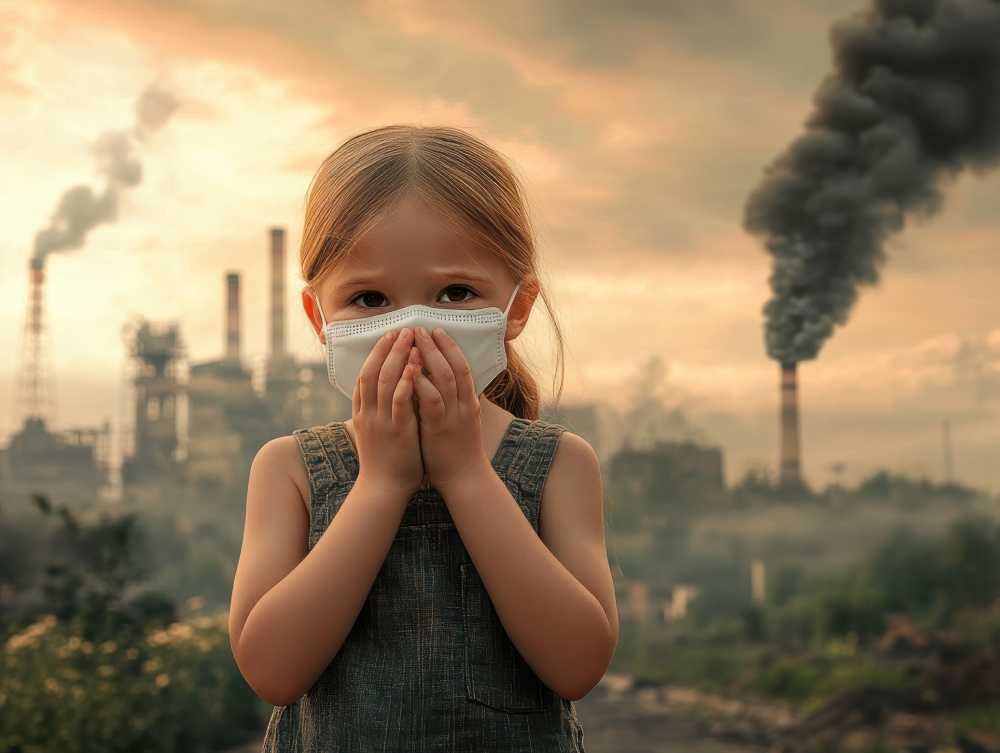Helping Our Children Breathe Easy – Fighting Air Pollution

Air pollution is a pressing issue that often dominates the news cycle. Unfortunately, we’ve become so accustomed to hearing about it that its gravity often fails to sink in. Let’s take a moment to reflect on its impact, particularly on our children, and explore ways to protect them.
Alarming Facts About Air Pollution and Children
- Children are the most affected: Their developing lungs and immune systems are especially vulnerable.
- 26% of newborn deaths are linked to air pollution, contributing to low birth weight and pre-term delivery.
- 15% of deaths in children under 5are attributed to air pollution due to respiratory infections and related conditions.
- Adults exposed to polluted air during childhood often develop chronic respiratory problems later in life.
Understanding Air Pollution
Air pollution occurs when harmful substances like gases, particles, or chemicals contaminate the air, reducing its quality. The gray haze we often see is a visible sign of dangerously polluted air.
Common Sources of Air Pollution
- Factories and power plants: Fossil fuel combustion is a major contributor.
- Road traffic: Vehicle emissions significantly pollute the air.
- Improper waste management: Poor disposal methods release harmful substances into the air.
- Agricultural activities: Excessive use of fertilizers and burning agricultural waste.
- Household sources: Forest fires, coal, and wood-burning stoves.
How Air Pollution Affects Health
The primary culprit in polluted air is particulate matter 2.5 (PM2.5):
- These particles are about 1/30th the width of a human hair, allowing them to penetrate deep into the lungs and bloodstream.
- They increase the risk of respiratory illnesses, cardiac conditions, strokes, and lung cancer.
- For pregnant women, PM2.5 can harm fetal development, leading to miscarriages, pre-term births, or low birth weight.
Impact on Children
Air pollution’s impact on children can be immediate and lifelong, with many effects being irreversible:
- Increased risk of asthma, pneumonia, bronchitis, and other respiratory conditions.
- Aggravation of pre-existing health issues.
- Impaired physical and cognitive development, affecting education and social interactions.
- Long-term health complications that may persist into adulthood.
For unborn children, exposure during pregnancy can lead to:
- Miscarriages or pre-term delivery.
- Low birth weight and brain development issues.
Recognizing Symptoms of Air Pollution
- Adults and older children: Dry eyes, redness, fatigue, headaches, runny nose, and aggravated asthma symptoms.
- Babies: Difficulty breathing or signs of exertion while breathing.
Protecting Our Children
Air pollution is a global issue that demands collective action. Here’s how we, as parents, can make a difference:
Indoor Precautions
- Use clean cooking fuels like LPG, electricity, or solar stoves.
- Ensure proper ventilation in kitchens with exhaust fans or open windows.
- Choose low-emission building materials, paints, and cleaning products.
- Consider installing HEPA filters to purify indoor air.
- Promote a healthy lifestyle: breastfeed exclusively for six months, ensure timely vaccinations, and encourage regular physical activity.
Outdoor Precautions
- Stay updated on local air pollution levels and plan activities accordingly.
- Avoid high-traffic or industrial areas.
- Limit strenuous outdoor activities during peak pollution periods, especially for children with respiratory conditions.
- Keep children indoors when air quality is visibly poor.
Creating a Cleaner Future
Small changes in our daily lives can collectively make a significant impact:
- Reduce vehicle usage by walking, cycling, or carpooling.
- Conserve energy by turning off lights and using energy-efficient appliances.
- Switch to eco-friendly, water-based cleaning products.
- Raise awareness within your community.
- Advocate for stronger government policies to reduce air pollution.
A Shared Responsibility
Clean air is not a luxury; it is a basic right. By working together, we can ensure our children grow up in a healthier, safer environment. Let’s take action today to help them breathe easy tomorrow.
Frequently Asked Questions
1. How does air pollution affect children differently than adults?
Children’s developing lungs and immune systems make them more vulnerable to respiratory and cognitive issues caused by air pollution.
2. What are the major sources of air pollution?
Key sources include vehicle emissions, factories, improper waste disposal, agricultural activities, and household pollutants like wood-burning stoves.
3. What are the symptoms of air pollution exposure in children?
Symptoms include dry eyes, difficulty breathing, aggravated asthma, fatigue, and headaches. Babies may show signs of exertion while breathing.
4. How can I reduce my child’s exposure to air pollution indoors?
Use clean cooking fuels, install HEPA filters, ensure ventilation, and choose low-emission building materials and paints.
5. What outdoor precautions can I take during high pollution days?
Avoid outdoor activities during peak pollution, stay away from high-traffic areas, and monitor local air quality reports.
6. What steps can I take to contribute to cleaner air?
Reduce vehicle use, conserve energy, switch to eco-friendly products, and advocate for stricter anti-pollution policies.
- Nov 25, 2024
